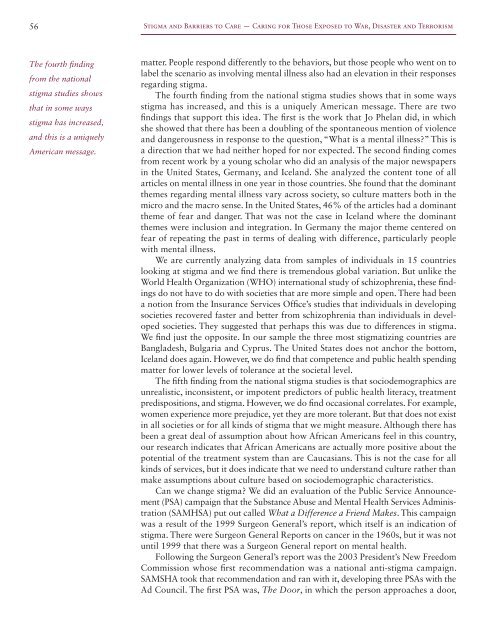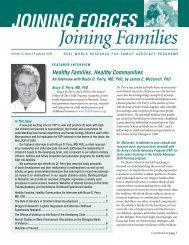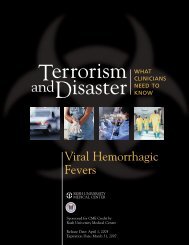stigma and barriers to care - Uniformed Services University of the ...
stigma and barriers to care - Uniformed Services University of the ...
stigma and barriers to care - Uniformed Services University of the ...
You also want an ePaper? Increase the reach of your titles
YUMPU automatically turns print PDFs into web optimized ePapers that Google loves.
56<br />
Stigma <strong>and</strong> Barriers <strong>to</strong> Care — Caring for Those Exposed <strong>to</strong> War, Disaster <strong>and</strong> Terrorism<br />
The fourth finding<br />
from <strong>the</strong> national<br />
<strong>stigma</strong> studies shows<br />
that in some ways<br />
<strong>stigma</strong> has increased,<br />
<strong>and</strong> this is a uniquely<br />
American message.<br />
matter. People respond differently <strong>to</strong> <strong>the</strong> behaviors, but those people who went on <strong>to</strong><br />
label <strong>the</strong> scenario as involving mental illness also had an elevation in <strong>the</strong>ir responses<br />
regarding <strong>stigma</strong>.<br />
The fourth finding from <strong>the</strong> national <strong>stigma</strong> studies shows that in some ways<br />
<strong>stigma</strong> has increased, <strong>and</strong> this is a uniquely American message. There are two<br />
findings that support this idea. The first is <strong>the</strong> work that Jo Phelan did, in which<br />
she showed that <strong>the</strong>re has been a doubling <strong>of</strong> <strong>the</strong> spontaneous mention <strong>of</strong> violence<br />
<strong>and</strong> dangerousness in response <strong>to</strong> <strong>the</strong> question, “What is a mental illness” This is<br />
a direction that we had nei<strong>the</strong>r hoped for nor expected. The second finding comes<br />
from recent work by a young scholar who did an analysis <strong>of</strong> <strong>the</strong> major newspapers<br />
in <strong>the</strong> United States, Germany, <strong>and</strong> Icel<strong>and</strong>. She analyzed <strong>the</strong> content <strong>to</strong>ne <strong>of</strong> all<br />
articles on mental illness in one year in those countries. She found that <strong>the</strong> dominant<br />
<strong>the</strong>mes regarding mental illness vary across society, so culture matters both in <strong>the</strong><br />
micro <strong>and</strong> <strong>the</strong> macro sense. In <strong>the</strong> United States, 46% <strong>of</strong> <strong>the</strong> articles had a dominant<br />
<strong>the</strong>me <strong>of</strong> fear <strong>and</strong> danger. That was not <strong>the</strong> case in Icel<strong>and</strong> where <strong>the</strong> dominant<br />
<strong>the</strong>mes were inclusion <strong>and</strong> integration. In Germany <strong>the</strong> major <strong>the</strong>me centered on<br />
fear <strong>of</strong> repeating <strong>the</strong> past in terms <strong>of</strong> dealing with difference, particularly people<br />
with mental illness.<br />
We are currently analyzing data from samples <strong>of</strong> individuals in 15 countries<br />
looking at <strong>stigma</strong> <strong>and</strong> we find <strong>the</strong>re is tremendous global variation. But unlike <strong>the</strong><br />
World Health Organization (WHO) international study <strong>of</strong> schizophrenia, <strong>the</strong>se findings<br />
do not have <strong>to</strong> do with societies that are more simple <strong>and</strong> open. There had been<br />
a notion from <strong>the</strong> Insurance <strong>Services</strong> Office’s studies that individuals in developing<br />
societies recovered faster <strong>and</strong> better from schizophrenia than individuals in developed<br />
societies. They suggested that perhaps this was due <strong>to</strong> differences in <strong>stigma</strong>.<br />
We find just <strong>the</strong> opposite. In our sample <strong>the</strong> three most <strong>stigma</strong>tizing countries are<br />
Bangladesh, Bulgaria <strong>and</strong> Cyprus. The United States does not anchor <strong>the</strong> bot<strong>to</strong>m,<br />
Icel<strong>and</strong> does again. However, we do find that competence <strong>and</strong> public health spending<br />
matter for lower levels <strong>of</strong> <strong>to</strong>lerance at <strong>the</strong> societal level.<br />
The fifth finding from <strong>the</strong> national <strong>stigma</strong> studies is that sociodemographics are<br />
unrealistic, inconsistent, or impotent predic<strong>to</strong>rs <strong>of</strong> public health literacy, treatment<br />
predispositions, <strong>and</strong> <strong>stigma</strong>. However, we do find occasional correlates. For example,<br />
women experience more prejudice, yet <strong>the</strong>y are more <strong>to</strong>lerant. But that does not exist<br />
in all societies or for all kinds <strong>of</strong> <strong>stigma</strong> that we might measure. Although <strong>the</strong>re has<br />
been a great deal <strong>of</strong> assumption about how African Americans feel in this country,<br />
our research indicates that African Americans are actually more positive about <strong>the</strong><br />
potential <strong>of</strong> <strong>the</strong> treatment system than are Caucasians. This is not <strong>the</strong> case for all<br />
kinds <strong>of</strong> services, but it does indicate that we need <strong>to</strong> underst<strong>and</strong> culture ra<strong>the</strong>r than<br />
make assumptions about culture based on sociodemographic characteristics.<br />
Can we change <strong>stigma</strong> We did an evaluation <strong>of</strong> <strong>the</strong> Public Service Announcement<br />
(PSA) campaign that <strong>the</strong> Substance Abuse <strong>and</strong> Mental Health <strong>Services</strong> Administration<br />
(SAMHSA) put out called What a Difference a Friend Makes. This campaign<br />
was a result <strong>of</strong> <strong>the</strong> 1999 Surgeon General’s report, which itself is an indication <strong>of</strong><br />
<strong>stigma</strong>. There were Surgeon General Reports on cancer in <strong>the</strong> 1960s, but it was not<br />
until 1999 that <strong>the</strong>re was a Surgeon General report on mental health.<br />
Following <strong>the</strong> Surgeon General’s report was <strong>the</strong> 2003 President’s New Freedom<br />
Commission whose first recommendation was a national anti-<strong>stigma</strong> campaign.<br />
SAMSHA <strong>to</strong>ok that recommendation <strong>and</strong> ran with it, developing three PSAs with <strong>the</strong><br />
Ad Council. The first PSA was, The Door, in which <strong>the</strong> person approaches a door,




